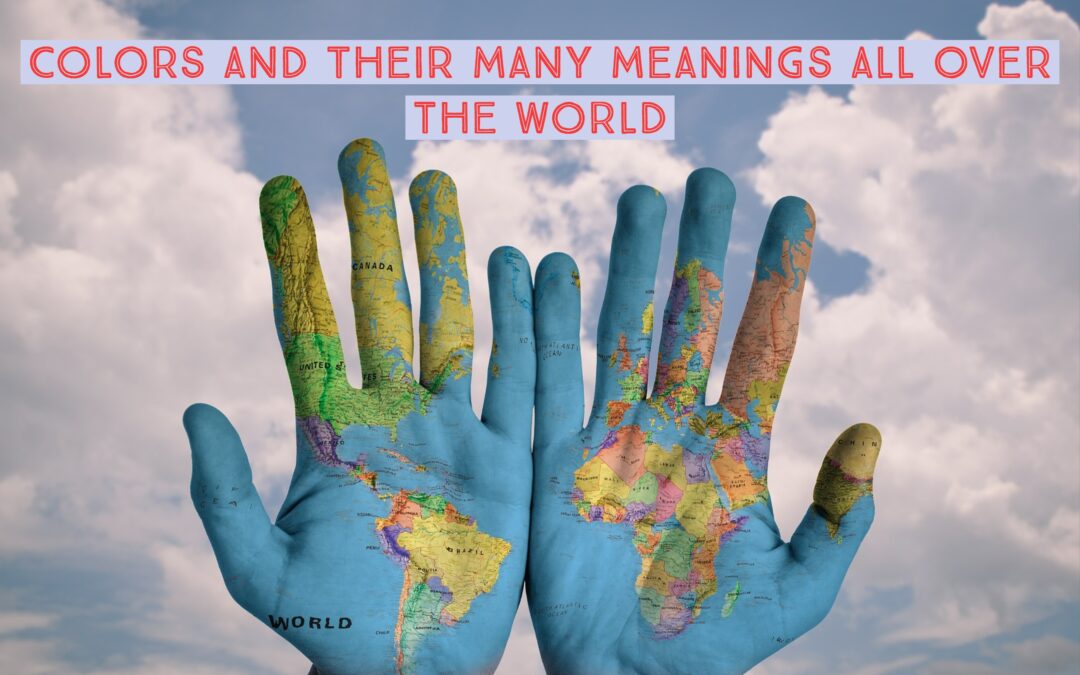[vc_row height=”auto”][vc_column][vc_column_text]
Cultures differ in many ways, from food to traditions to religion. But have you ever thought about how the differing symbolism and meaning when it comes to color? Have you ever wondered why some cultures wear black to funerals, but some wear white? Take a look at the different colors and how they differ from culture to culture.
RED
In Western cultures, red is constantly associated with power, passion, love, energy, and danger. Red is the color of love (as hearts are colored red) and Valentine’s Day (a holiday of love) is decorated in all red. The red rose is the flower that is considered to be a symbol of love and is usually given to someone in a romantic way.
Talking just about danger specifically, that is possibly a reason why all stop signs and traffic lights associate red with stop in America. When you see a red stop sign or yield sign, not only does it stand out to you, it’s commonly associated with stopping, even if you do not necessarily see the words.
In Asian and Eastern cultures, however, red is not considered dangerous. It represents good luck, joy, prosperity, celebration, and happiness. This is the reason that one of the main colors in the Chinese New Year celebration is the color red.
ORANGE
Orange is the color of fall and fire. In India, orange is considered to be a sacred religious color. It is represented in Hinduism as getting rid of or burning away impurities to be made whole. However, in most countries, it is not considered sacred or pure, it simply symbolizes warmth, good luck, happiness, and courage.
[/vc_column_text][/vc_column][/vc_row][vc_row][vc_column width=”1/2″][vc_column_text]
YELLOW
Yellow is commonly known as a happy color. People of all different nationalities think of optimism and joy as the color of yellow. Worldwide, they use yellow paint to promote happiness in the home, and used for smiley faces and other optimistic things. Yellow is also considered to be a color associated with high rank and success in African and Asian societies. Interestingly enough, although most civilizations use yellow for joy and happiness, there are some pessimistic meanings to yellow. Due to the brightness of the color, it can be associated with warning signs. For example, the traffic light meaning yield or slow down, to alert drivers that the light is about to turn red. In Latin Cultures, specifically Mexico, yellow has the meaning of death and mourning. During the Inquisition, the government would dress up prisoners who had committed treason in the color yellow.
[/vc_column_text][/vc_column][vc_column width=”1/2″][us_separator height=”120px” size=”custom”][us_image image=”25675″ align=”center”][/vc_column][/vc_row][vc_row height=”auto”][vc_column][vc_column_text]
GREEN
When thinking of the color green, many people think of luck. A reason for this can be credited to St. Patrick’s Day, a holiday celebrated by many countries worldwide. It is custom on St. Patrick’s Day to wear the color green, started by the color of the lucky four-leaf clover. Many religions accredit the green four-leaf clover to luck, because of how rare it is to find a four-leaf clover. Over time, the color green has stuck with many countries and they still to this day use the color green as a symbolism of luck and positive qualities. New life is a common meaning for the color, owing to the fact that spring and plants are green as they begin to grow and flourish. It is commonly affiliated with the environment as well and frequently used as a color to make an awareness of recycling, and environmental health. There are some differences between the color green, as in Brazil green has the meaning of death. Although in China, men go against the usual meaning by wearing green top hats to symbolize their wives committing adultery.
BLUE
Blue is a common color generally identifying with peace and serenity. It is a very calming color, as it is the color of the sky and the sea, calming nature. When looking at the different meanings of blue, I found two very different meanings. On one hand, Western, Eastern, and the Middle East all use blue as a meaning of peace, serenity, protection, safety, trust, and hope. It also is considered on the other extreme in America and Europe as depression, sadness, loneliness, and mourning. A common phrase is used as “feeling blue”, which means feeling sad or depressed.
[/vc_column_text][/vc_column][/vc_row][vc_row height=”small”][vc_column width=”1/2″][vc_column_text]
PURPLE
Purple is a very honorable color worldwide. The majority of societies relate purple to wealth, royalty, success, notability and spirituality. In Europe specifically, in certain ceremonies, the royal family will wear purple to symbolize their power. America uses the color purple to represent great honor and courageousness. They use the award the purple heart, to veterans who make courageous sacrifices for their country. Brazil has an opposite meaning than the countries talked about previously. When thinking of purple, they think of mourning and death.
[/vc_column_text][/vc_column][vc_column width=”1/2″][us_separator height=”64px” size=”custom”][us_image image=”25682″ align=”center”][/vc_column][/vc_row][vc_row height=”small”][vc_column][vc_column_text]
BLACK
It appears every country has one of two extreme meanings, positive or negative, to the color black. In America, Asian, European, and Middle East civilizations, a lot of the time they link black to death, evil, mourning, mystery, funerals, rebellion, and bad luck. While all of those attributes are considered negative, black also has some positives connected to it. In Eastern societies, the color represents wealth, health and prosperity. Africa has similar beliefs as Eastern societies, they consider black to be aligned with age, maturity, and masculinity.
WHITE
White is the color recurrently used to mean purity, cleanliness, and holiness. White is worn in Western weddings by the brides, and worn in baptisms, and holy ceremonies all over the world. In Asian and Eastern cultures, they do not believe that white should be identified with purity. It is considered a gloomy color, meaning death, sadness, and mourning. As stated earlier, it is worn at funerals instead of black, the color most countries wear.
[/vc_column_text][/vc_column][/vc_row][vc_row height=”auto”][vc_column width=”5/6″][vc_column_text][widget id=”email-subscribers-15″][/vc_column_text][/vc_column][vc_column width=”1/6″][us_separator size=”custom” height=”32px”][/vc_column][/vc_row]


Recent Comments